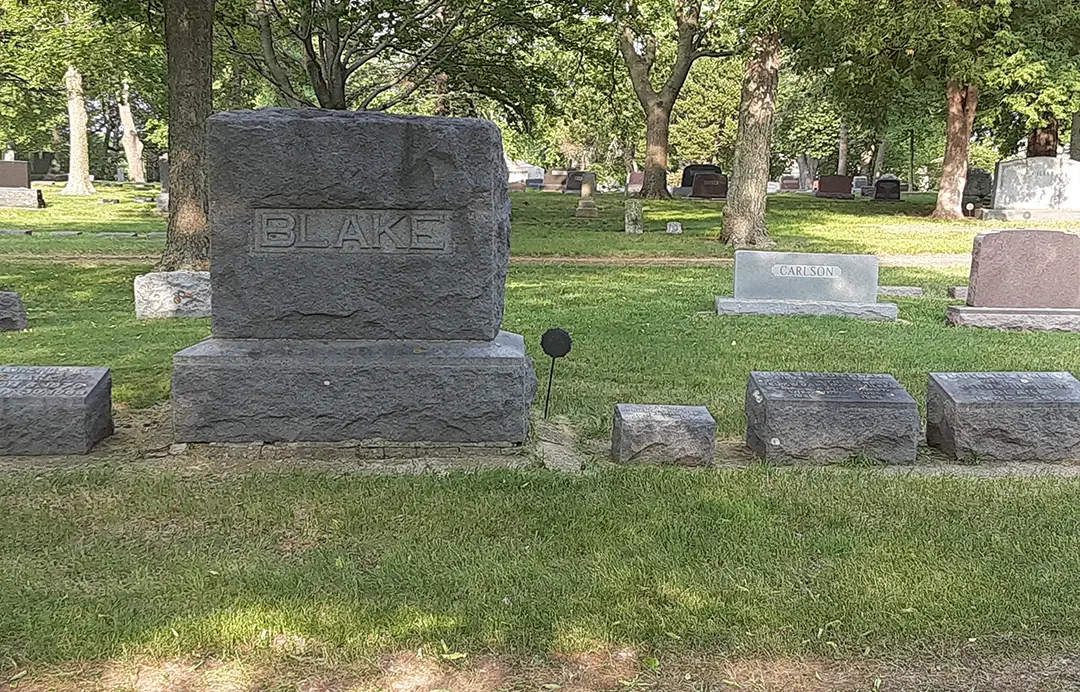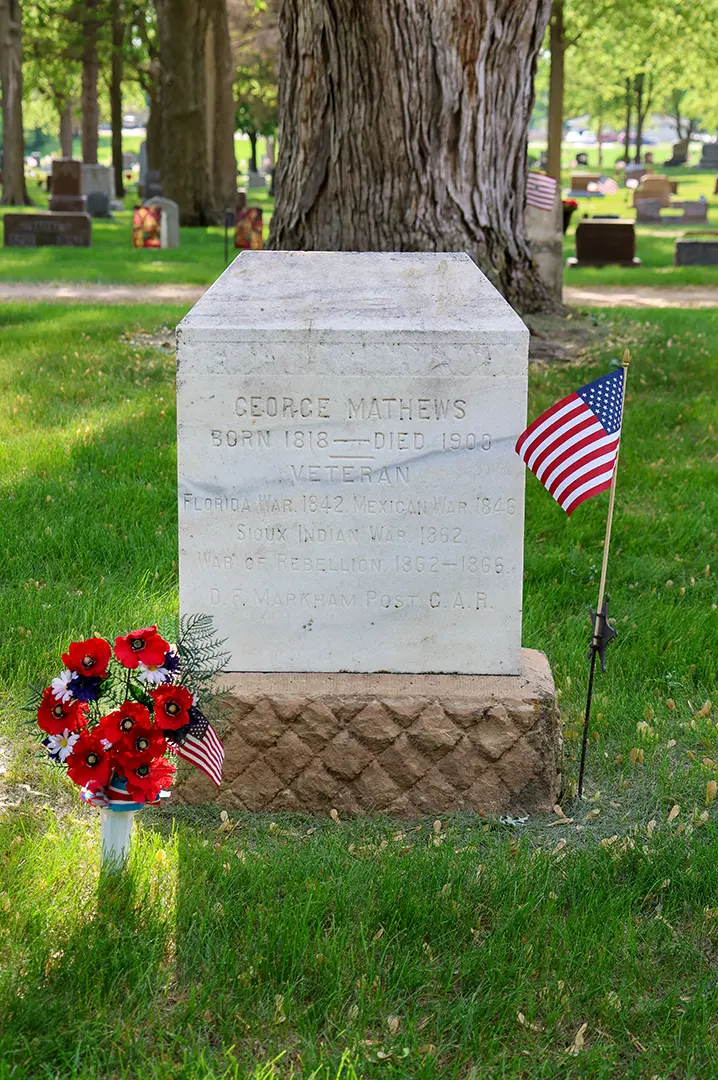History of the Marshall Cemetery

First Settlers Arrive
The first settlers on the present site of Marshall were W.H. Langdon, C.H. Whitney and C.H. Upton. They arrived in June 1869 and built sod shanties for homes. The village of Marshall was platted in August 1872 when the Winona and St. Peter Railroad was established through Lake Marshall Township. Marshall became official when the Act of Incorporation for the Town of Marshall was approved on February 17, 1876.
Marshall Cemetery Established
The Marshall Cemetery was established just a few years after the arrival of the first white settlers and was overseen by the Lake Marshall Township Board. By the mid-1890s, the Lake Marshall Township no longer wanted the responsibility of maintaining the cemetery. At the request of the Township Board, the Marshall Cemetery Association was created as a nonprofit corporation on October 29, 1897. The Lake Marshall Township donated the entire 40-acre plot of land the cemetery was located on to the Association, to be used for burials and to generate income to maintain the cemetery into the future. In 1937, the Cemetery Association added another 9 acres along the south side of the cemetery. Those 49 acres comprise the extent of the cemetery as it exists today. Currently, approximately 30 acres of the cemetery property have been developed for burials.

Interesting Facts
There are over 5100 people recorded as buried in the cemetery as of the end of December 2022.
The first person found in our records to have been buried in the cemetery was L. D. Wright. He was 70 years old according to our information and was buried in Block 15, Lot 9, Grave 1 in 1871.


The oldest person (based on date of birth) known to be buried in the cemetery is Martha Gibbs (1789-1874) in Block 15, Lot 6, Grave 6. This does not mean she was the oldest, only the oldest one that we have determined thus far in searching our records. Martha was born two years after the U.S. Constitution was written and in the same year that it became the governing document of our country. She was 10 years old when George Washington died in 1799. She was buried prior to the establishment of the Marshall Cemetery Association. (In those years, Lake Marshall Township Board was managing the cemetery, and our records have very little data from that time period.)

Major John Winslow Blake, one of Marshall’s founding fathers, is buried in Block 21, Lot. 12, Grave. Major Blake was also instrumental in founding the local chapter of the Grand Army of the Republic.
The Marshall Cemetery is old enough to actually have a “Potter’s Field”. Webster defines Potter’s Field as “a public burial place for paupers, unknown persons and criminals”. The term originated in the 27th chapter of Matthew, when Judas brought back the 30 pieces of silver to the chief priest. Verse 6 reads: “But the chief priest, taking the pieces of silver, said ‘It is not lawful to put them into the treasury, since they are blood money.’ So they took counsel, and bought with them the potter’s field to bury strangers in.”
On March 11, 1899, the Marshall Cemetery Association Board recorded that out of 35 graves in the Potter’s Field, only 9 of them were known by name. It also stated that there were two unpaid graves in the main cemetery and that those bodies should be dug up and moved [to Potter’s Field] and that the cemetery should resell the graves. It is believed that our Potter’s Field is probably located in an area along the north side of the established cemetery, but no one on the Board today is certain of its location.

In 1882, Andrew and Anna Nelson lost five children in two months due to scarlet fever: on Feb. 27th, Willie A., age 7, and Marie Josephine, age 9; on March 4th, Custer Daniel, age 2, and Louis J., age 13; and March 13th, Clara Emilie, age 14. There were 14 deaths recorded in 1882, and 9 were from scarlet fever. The Nelson family monument is located in Block 31, Lot 10, Graves 4-8.

Harriet Tucker (1819-1908) is credited as one of the founders of the Institute for the Blind at Faribault, Minnesota. In 1864, while riding in a stage with state Senator J.V. Daniels, Secretary of State David Blakeley, and eventual Lieutenant Governor Thomas Armstrong, she planted the idea of a school for the blind. With their help and by writing letters to other senators, the school became a reality two years later. At that time, she was elected by the trustees of the institution to be the first principal. Her monument is in Block 10, Lot 11, Grave 2.

Military Veterans
- 1 War of 1812 veteran
- 51 World War I veterans
- 50+ Korean War veterans
- 58 Civil War veterans
- 160+ World War II veterans
- 23 Vietnam War veterans
There are two veterans from the war of 1812 buried in Lyon County; one is buried in Russell and one in our cemetery. Thomas Hicks was first buried elsewhere in 1873 or 1874 (probably in the original Catholic cemetery) and was moved here in 1911. (Block 50, Lot 3, Grave 5.)

The Grand Army of the Republic was organized in 1866 in Illinois. The membership was limited to Union (Northern) veterans of the Civil War. By the 1880s, there were more than 400,000 members across the U.S. The GAR building still stands in Litchfield, Minnesota, and is a museum today. Under the large tree near the center of our cemetery, an area was originally reserved for members of the GAR. Commemorative Memorial Day ceremonies honoring all our fallen Veterans are held there each year.

George Mathews was a member of the Grand Army of the Republic and is buried in the area reserved for members (Block 24, Lot 6, Grave 2). On George’s headstone is a record of his service to our nation. It shows that he was already a veteran of three separate wars prior to serving in the Union Army in the Civil War (called the “War of Rebellion” on his monument). Over his career, Mr. Mathews enlisted five different times and received six discharges.


Two of our veterans died in the fighting in World War I. Luther Snapp (Block 48, Lot 8, Grave 2) was killed in action on July 28, 1918, and was buried in France. Earl Jackson (Block 56, Lot 9, Grave 1) was killed in action on October 7, 1918, and was also buried in France. After the war, at the family’s request, the bodies were brought back to Marshall for burial. The funeral service was handled by the Luther I. Snapp Post of the American Legion on August 7, 1921. The funeral was so large that it was held outside on the courthouse lawn. You can see pictures of the funeral procession at the Lyon County Museum.

